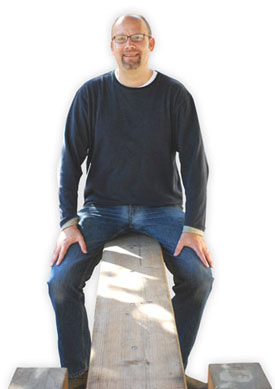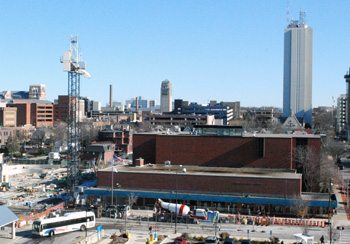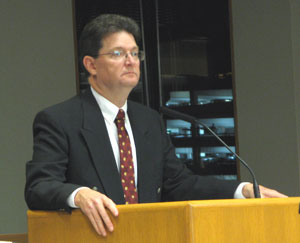Ann Arbor city council meeting (Nov. 21, 2011): After the ceremonial swearing in of councilmembers who won their elections on Nov. 8, the council devoted more time to deliberations on modifying its public art ordinance than on any other item on its agenda.

Before the Nov. 21 meeting, former councilmember Leslie Morris (left) might be reminding Jane Lumm (Ward 2) which ward Lumm represents on the Ann Arbor city council. (Photos by the writer.)
In the end, the council gave initial approval to an ordinance amendment that would temporarily reduce the required allocation to public art from city capital improvement projects – from 1% to 0.5% for a period of three years. After three years, the percentage would automatically revert to 1%. Of the various amendments to the ordinance, the percentage of the required allocation was the focus of the most controversy during council deliberations. A bid by Jane Lumm (Ward 2) to lower the percentage further to 0.25% gained little support.
Other art ordinance amendments given the council’s initial approval include a requirement that public art money be returned to its fund of origin after three years, if not encumbered by a specific art project. The amendment also included a definitional change that effectively excludes sidewalk repair from the public art ordinance. The amendments also addressed the general fund, making explicit the exclusion of general fund projects from the public art ordinance.
During deliberations, city staff confirmed that at least a portion of the public art allocation required from the new municipal building (aka the police/courts building) could be associated with the general fund – about $50,000 out of the $250,000. [This is for art in the interior of the building, and is separate from the outdoor fountain designed by German artist Herbert Dreiseitl.]
As part of her Ward 2 election campaign, Jane Lumm had argued that general fund dollars were connected to supporting public art at the new municipal building – an idea that had been, until Monday’s meeting, poo-pooed by some councilmembers, including mayor John Hieftje, who had said no general fund money had been used for the public art program.
Lumm was active in her first council meeting since serving in the 1990s. During deliberations on a revision to the ordinance on the city’s greenbelt boundaries, she prompted extended discussion on the part of the revision dealing with the boundary expansion. A less controversial part of the proposed revision involved allowing parcels adjacent to the boundary to be eligible for protection. In the end, the council gave initial approval to both parts of the greenbelt boundary change.
Also related to land use were two site plans on the agenda. The council gave initial approval to altering the University Bank site plan for its property at 2015 Washtenaw Ave., known as the Hoover Mansion. And the council signed off on the site plan, as well as the brownfield plan, for Arbor Hills Crossing, a proposed retail and office complex at Platt and Washtenaw.
Because the content of a proposed revision to the city’s littering and handbill law was not available to the public until late in the day Monday, just before the council met, the council postponed its consideration of that item. The ordinance amendment would allow residents to prevent delivery of unwanted newspapers to their homes by posting a notice on their front doors.
In other business, the council expressed its opposition to a bill pending in the Michigan legislature that would nullify an Ann Arbor ordinance on non-discrimination against people based on sexual orientation, gender identity, or student status. At the meeting, the council also authorized acceptance of several grants for the 15th District Court for programs on domestic violence and substance abuse.
In routine business for the first council meeting after newly elected councilmembers take office, the council elected Marcia Higgins (Ward 4) as mayor pro tem. Committee appointments and rule changes were postponed until Dec. 5. [Full Story]











